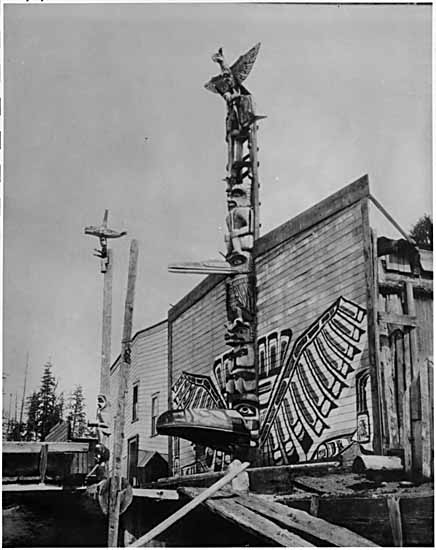Prompt: amend aspects of Silko’s story of how evil came into the world (King 9) and discuss experience of telling it, orally, to others.
Note: regular font is first draft; bolded font is stuff I added post-telling. Update May 31: Added a link to alien conspiracy theories, if anyone’s into that kind of stuff.
The story
So you know how there’s this conspiracy theory that aliens have visited our planet and been in cahoots with some of our leaders for thousands of years? That Jesus Christ, Buddha, or Quetzalcoatl were actually aliens. Well, I’m here to tell you that’s actually true.
Aliens first visited Earth around the time most of us were still figuring out how to build fires and feed ourselves. The aliens came to Earth in their shiny spaceships and looked around at all the humans scratching around for food.
Seeing the humans work so hard (but so pathetically) to carve out a living, the aliens decided to help them. They taught the humans how to build fires, make bows and arrows, raise animals, and the basics of farming. The humans were eager learners and listened tirelessly to the aliens, who were impressed by their curiosity, imagination, and ability to learn.
When it was time for the aliens to go (their ships needed re-fueling), they gathered the humans and threw a farewell party. The humans didn’t want the aliens to leave, because although the aliens had taught them so many new skills, they obviously didn’t have time to teach them everything. So the alien chief said, “Why don’t you guys ask us one last question, and we’ll do our best to answer it? Any question you wish. But we only have time for one.”
The humans talked among themselves: what could they ask the aliens? How to build a spaceship? What the hell was electricity? How to improve the irrigation system? And while all the adults were discussing all this, a young child at the front of the crowd—no one remembers if it was a boy or girl—decided to pose this question: “Sir, you’ve taught us how to make weapons and hunt, killing animals for food. But what happens if we use those weapons to kill a person??”
Everyone stopped talking. Until then, no human and ever killed another human. The concept did not exist.
“Well, child, that’s murder,” said the alien chief, “and murder is terrible.”
The child was still curious. “Could you explain a little more?”
“It’s very painful, and it’s very sad. It’s something only bad individuals will do, to rob, to avenge, to delight in the pain of others.” Then, in order to help the child further understand, the alien chief proceeded to tell the humans a folktale among their own culture, one about two brothers. The older brother was heir to their parents’ farm, and the younger brother killed the older brother for it. The murderous brother shot his brother through the heart with an arrow, stabbed his neck with a knife, and left him in a field to die. He did all this to get the inheritance he couldn’t have. “Sometimes good things, like inheritances, can happen to bad people, like murders,” said the alien chief. “Unfortunately, this is the way of the world.”
After hearing this story the humans were all silent, and the alien chief regretted telling it right away. But it was time to go, and so the aliens left.
The aliens visited again a hundred years later. By then, Earth had changed drastically. The humans were all living in their own walled and fenced communities. Their cattle and crops were firmly protected by people armed with bows and arrows, not to shoot at prey, but to shoot at other people.
You see, you have to be very careful with the stories you tell and the stories you listen to, because once a story is told, it can never be taken back.
The experience
I really liked the original version of the story, but I wanted to make my version “contemporary”—hence the sci-fi alien conspiracy theory stuff—and more casual, told like the story of Charm in King’s novel. I told this story to a friend while we were riding the bus, and she described it as “a mix of sci-fi and Aesop’s fable.”
I drafted the story here first. Upon returning, I realized I’d left out some finer details, including words that might have made the story more exciting. I also added words spontaneously in my tellings, such as describing the humans as “pathetic.” One listener, when she heard the story, also posed the question “Why would a kid who knew nothing of murder ask about murder?” so I had to fill in that (quite obvious) gaping detail by mentioning that he/she made the connection with hunting for animals. I also fleshed out the aliens’ story by giving it a more definitive ending. One thing I regret is forgetting to start with “I have a great story to tell you” as suggested in the prompt; instead I used something along the lines of “Would you like to hear a story?” I wonder if the opener would have changed the audience’s perception.
Storytelling was more difficult than I expected. I’m a creative writing major, so I’m used to fine-tuning my sentences before going public. I’m not the most collected speaker, so speaking smoothly was hard. However, I like gesturing, and I used hand motions to accentuate the violence of the fraternal killing. That was fun.
I wanted to be entertaining, but gee, being entertaining is hard. And Mark Twain agrees: “There are several kinds of stories, but only one difficult kind—the humorous . . . The humorous story is strictly a work of art—high and delicate art— and only an artist can tell it.”
When I googled “how to tell a story,” surprisingly, I found many business articles such as this one. I never connected something as “artsy” as storytelling to the commerce world, but now I can see it as a useful transferable skill.
Sorry for the extra-long post! And thanks for sticking to the end 🙂
Works Cited
King, Thomas. The Truth About Stories: A Native Narrative. Toronto: House of Anansi Press Inc., 2003.
Works Consulted
The Purdue OWL. Purdue U Writing Lab, 2010. Web. 28 May 2015.

